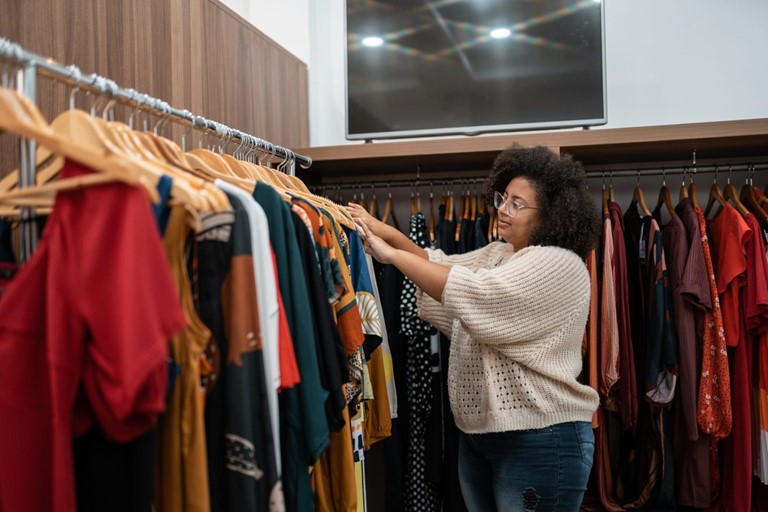
對Ozempic和Wegovy減肥藥用戶來說,減肥成了瘋狂購物的理由,,奢侈品經(jīng)銷商也在密切關(guān)注,。二手奢侈品時尚市場發(fā)現(xiàn)人們在減肥過程中會更新衣柜,,而減肥藥物日益普及可能加快趨勢。
據(jù)《Vogue Business》報道,,二手時尚平臺Poshmark稱過去兩年中大碼服裝上架數(shù)量增加了103%,,其中3XL增加103%,4XL增加80%,,5XL增加73%,。Poshmark還指出,在具體描述或標(biāo)題中提到“減肥”的新商品增加了78%,。
“隨著減肥新藥不斷出現(xiàn),,我們預(yù)計Poshmark將協(xié)助客戶踏入新生活方式,”Poshmark聯(lián)合創(chuàng)始人兼商品副總裁特雷西·孫告訴《Vogue Business》,,“我們發(fā)現(xiàn)供需變化,,密切關(guān)注趨勢,從而為客戶提供貼心服務(wù),?!?/p>
除了美國人逐漸拋棄大碼衣服,服用GLP-1減肥藥的人們買新衣服同樣推動了趨勢,。設(shè)計師服裝租賃平臺Rent the Runway聯(lián)合創(chuàng)始人兼首席執(zhí)行官珍妮弗·海曼留意到,,與過去15年相比,越來越多消費(fèi)者購買衣服的尺碼變小,。Lafayette和Amarra等高端時尚和奢侈品牌也發(fā)現(xiàn)了這一趨勢,。
市場研究公司凱度(Kantar)咨詢部門副總裁利·奧唐納告訴《財富》雜志,購物趨勢變化很有可能與越來越多消費(fèi)者使用減肥藥有關(guān),。減肥的人們可能會很快更換不同尺寸的衣服,,他們會去二手市場處理而不是買新衣服。奧唐納表示,,如果想處理不再合身的舊衣服,,通過轉(zhuǎn)售平臺能獲得積分,進(jìn)一步激勵用戶在平臺上購買,。
不過對于第一次達(dá)到目標(biāo)體重的人來說,,購物還有額外的吸引力,就是進(jìn)一步凸顯個人風(fēng)格,。Ozempic減肥用戶在雜貨和家居用品方面購物習(xí)慣改變,,傾向營養(yǎng)更豐富或質(zhì)量更好的商品,對衣柜的調(diào)整可能也一樣,。
“尤其是努力重塑自己時,,可能不再會選可穿可不穿的衣服,”奧唐納說,。
Ozempic如何改變消費(fèi)品
約八分之一美國人嘗試過Ozempic或Wegovy等GLP-1抑制劑控制體重,,隨著人們體型和所需衣物尺寸變化,,時尚界受到刺激也就順理成章。美國人口普查局(U.S. Census Bureau)的數(shù)據(jù)顯示,,由于消費(fèi)者信心疲軟,,時尚行業(yè)表現(xiàn)不佳,截至5月服裝和配飾銷售額同比下降0.9%,。
Ozempic減肥藥引發(fā)的影響對二手奢侈品行業(yè)的利好作用可能更明顯,,正是二手奢侈品行業(yè)扭轉(zhuǎn)了時尚行業(yè)下滑的趨勢。由于熱衷昂貴產(chǎn)品的消費(fèi)者受通脹影響,,努力尋找價廉物美的平替,,高端商品轉(zhuǎn)賣的增速已是一手奢侈品市場的兩倍。管理咨詢公司貝恩(Bain & Co.)的數(shù)據(jù)顯示,,2023年奢侈品轉(zhuǎn)售市場達(dá)到490億美元,,預(yù)計今年增速為1%至4%。
其他行業(yè)已抓住機(jī)會,,吸引了不斷增長的Ozempic減肥用戶群體,。雀巢專門為GLP-1減肥用戶推出了一系列小份冷凍食品?;蹆p體(WeightWatchers)則計劃提供Wegovy等減肥藥,。
但大規(guī)模變化也存在風(fēng)險,因為很大程度上來說相關(guān)藥物的長期影響仍然未知,,很多人停止服藥后體重會反彈,。雖然現(xiàn)在Ozempic成了熱潮,對消費(fèi)品的持久影響還很難說,。
盡管時尚市場努力跟上時代發(fā)展,,仍然存在風(fēng)險,。奧唐納說,,服用減肥藥的人可能更愿意買新衣服,但在達(dá)到理想體重之前不一定會大手筆買奢侈品,。
“幾乎所有跟我談過GLP-1的人都說,,‘我想買衣服,但現(xiàn)在還沒減到位,,所以會忍住,,’”她說。
問題不僅僅在二手市場方面,。人工智能預(yù)測公司Impact Analytics的創(chuàng)始人兼首席執(zhí)行官普拉尚特·阿格拉瓦指出,,隨著服裝尺寸縮小,服裝生產(chǎn)商在適應(yīng)方面可能越來越痛苦,。該公司發(fā)現(xiàn),,隨著更多人服用減肥藥,,零售商也在調(diào)整尺碼模型適應(yīng)更纖細(xì)的身材。
尺寸曲線,,或者叫零售商為消費(fèi)者提供的一系列尺寸,,在庫存?zhèn)湄洉r一直有碰運(yùn)氣的成分。消費(fèi)者傾向更小號衣服后,,確定尺碼曲線愈加困難,。一旦曲線出錯,服裝公司每年因庫存過剩和資源浪費(fèi)損失可能高達(dá)2000萬美元,。
阿格拉瓦在一份聲明中表示:“零售商要密切關(guān)注動向,,這是可持續(xù)性問題??刹荒茏龀鲆欢焉唐纷詈鬀]人要,。”(財富中文網(wǎng))
譯者:梁宇
審校:夏林
對Ozempic和Wegovy減肥藥用戶來說,,減肥成了瘋狂購物的理由,,奢侈品經(jīng)銷商也在密切關(guān)注。二手奢侈品時尚市場發(fā)現(xiàn)人們在減肥過程中會更新衣柜,,而減肥藥物日益普及可能加快趨勢,。
據(jù)《Vogue Business》報道,二手時尚平臺Poshmark稱過去兩年中大碼服裝上架數(shù)量增加了103%,,其中3XL增加103%,,4XL增加80%,5XL增加73%,。Poshmark還指出,,在具體描述或標(biāo)題中提到“減肥”的新商品增加了78%。
“隨著減肥新藥不斷出現(xiàn),,我們預(yù)計Poshmark將協(xié)助客戶踏入新生活方式,,”Poshmark聯(lián)合創(chuàng)始人兼商品副總裁特雷西·孫告訴《Vogue Business》,“我們發(fā)現(xiàn)供需變化,,密切關(guān)注趨勢,,從而為客戶提供貼心服務(wù)?!?/p>
除了美國人逐漸拋棄大碼衣服,,服用GLP-1減肥藥的人們買新衣服同樣推動了趨勢。設(shè)計師服裝租賃平臺Rent the Runway聯(lián)合創(chuàng)始人兼首席執(zhí)行官珍妮弗·海曼留意到,,與過去15年相比,,越來越多消費(fèi)者購買衣服的尺碼變小。Lafayette和Amarra等高端時尚和奢侈品牌也發(fā)現(xiàn)了這一趨勢,。
市場研究公司凱度(Kantar)咨詢部門副總裁利·奧唐納告訴《財富》雜志,,購物趨勢變化很有可能與越來越多消費(fèi)者使用減肥藥有關(guān),。減肥的人們可能會很快更換不同尺寸的衣服,他們會去二手市場處理而不是買新衣服,。奧唐納表示,,如果想處理不再合身的舊衣服,通過轉(zhuǎn)售平臺能獲得積分,,進(jìn)一步激勵用戶在平臺上購買,。
不過對于第一次達(dá)到目標(biāo)體重的人來說,購物還有額外的吸引力,,就是進(jìn)一步凸顯個人風(fēng)格,。Ozempic減肥用戶在雜貨和家居用品方面購物習(xí)慣改變,傾向營養(yǎng)更豐富或質(zhì)量更好的商品,,對衣柜的調(diào)整可能也一樣,。
“尤其是努力重塑自己時,可能不再會選可穿可不穿的衣服,,”奧唐納說,。
Ozempic如何改變消費(fèi)品
約八分之一美國人嘗試過Ozempic或Wegovy等GLP-1抑制劑控制體重,隨著人們體型和所需衣物尺寸變化,,時尚界受到刺激也就順理成章,。美國人口普查局(U.S. Census Bureau)的數(shù)據(jù)顯示,由于消費(fèi)者信心疲軟,,時尚行業(yè)表現(xiàn)不佳,,截至5月服裝和配飾銷售額同比下降0.9%。
Ozempic減肥藥引發(fā)的影響對二手奢侈品行業(yè)的利好作用可能更明顯,,正是二手奢侈品行業(yè)扭轉(zhuǎn)了時尚行業(yè)下滑的趨勢,。由于熱衷昂貴產(chǎn)品的消費(fèi)者受通脹影響,努力尋找價廉物美的平替,,高端商品轉(zhuǎn)賣的增速已是一手奢侈品市場的兩倍,。管理咨詢公司貝恩(Bain & Co.)的數(shù)據(jù)顯示,2023年奢侈品轉(zhuǎn)售市場達(dá)到490億美元,,預(yù)計今年增速為1%至4%,。
其他行業(yè)已抓住機(jī)會,,吸引了不斷增長的Ozempic減肥用戶群體,。雀巢專門為GLP-1減肥用戶推出了一系列小份冷凍食品?;蹆p體(WeightWatchers)則計劃提供Wegovy等減肥藥,。
但大規(guī)模變化也存在風(fēng)險,因為很大程度上來說相關(guān)藥物的長期影響仍然未知,,很多人停止服藥后體重會反彈,。雖然現(xiàn)在Ozempic成了熱潮,,對消費(fèi)品的持久影響還很難說。
盡管時尚市場努力跟上時代發(fā)展,,仍然存在風(fēng)險,。奧唐納說,服用減肥藥的人可能更愿意買新衣服,,但在達(dá)到理想體重之前不一定會大手筆買奢侈品,。
“幾乎所有跟我談過GLP-1的人都說,‘我想買衣服,,但現(xiàn)在還沒減到位,,所以會忍住,’”她說,。
問題不僅僅在二手市場方面,。人工智能預(yù)測公司Impact Analytics的創(chuàng)始人兼首席執(zhí)行官普拉尚特·阿格拉瓦指出,隨著服裝尺寸縮小,,服裝生產(chǎn)商在適應(yīng)方面可能越來越痛苦,。該公司發(fā)現(xiàn),隨著更多人服用減肥藥,,零售商也在調(diào)整尺碼模型適應(yīng)更纖細(xì)的身材,。
尺寸曲線,或者叫零售商為消費(fèi)者提供的一系列尺寸,,在庫存?zhèn)湄洉r一直有碰運(yùn)氣的成分,。消費(fèi)者傾向更小號衣服后,確定尺碼曲線愈加困難,。一旦曲線出錯,,服裝公司每年因庫存過剩和資源浪費(fèi)損失可能高達(dá)2000萬美元。
阿格拉瓦在一份聲明中表示:“零售商要密切關(guān)注動向,,這是可持續(xù)性問題,。可不能做出一堆商品最后沒人要,?!保ㄘ敻恢形木W(wǎng))
譯者:梁宇
審校:夏林
Ozempic and Wegovy users are turning their weight loss into a reason for a shopping spree, and luxury resellers are watching. Secondhand luxury fashion markets are noticing people on weight-loss journeys shedding old wardrobes, noting that the rising popularity of obesity medicines could be driving the trend.
Secondhand fashion platform Poshmark revealed a 103% increase in plus-size clothing listings, including a 103% increase in 3XL, 80% in 4XL, and 73% in 5XL listings over the past two years, Vogue Business reported. Poshmark also noted a 78% increase in new items with the term “weight loss” in a description or listing title.
“With the rise of these new medications, we expect that Poshmark will support our customers through yet another life change,” Poshmark cofounder and vice president of merchandising Tracy Sun told Vogue Business. “We’re noticing shifts in supply and demand, and we monitor these trends closely to stay attuned to the customer.”
Combined with Americans getting rid of plus-size clothes is GLP-1 med users’ hunt for a new wardrobe. Jennifer Hyman, cofounder and CEO of designer apparel rental platform Rent the Runway, noticed that more of its consumers are purchasing smaller sizes than they have in the past 15 years. High-end fashion and luxury brands like Lafayette and Amarra are also aware of the trend.
There’s good reason these buying patterns could be associated with a growing base of consumers using weight-loss drugs, Leigh O’Donnell, market research firm Kantar’s consulting division vice president, told Fortune. Those in the process of losing weight may be cycling through different sizes of clothing, leading them to secondhand markets as opposed to buying new clothes. If you’re someone who’s getting rid of old clothes that no longer fit, you may accrue points through resale platforms, which incentivizes you to buy on those platforms, O’Donnell argued.
But for those who are reaching their target weight for the first time, there’s an added appeal to shopping: the prospect of developing a zhuzhed-up personal style. As Ozempic users change shopping habits for groceries and household goods, leaning toward items with denser nutrients or greater quality, they may have the same philosophy regarding their wardrobe.
“Especially if you’re reinventing yourself, you maybe don’t want to go for throwaway clothing,” O’Donnell said.
How Ozempic is shaking up consumer products
With about one in eight Americans having tried Ozempic or another GLP-1 inhibitor like Wegovy, it’s no surprise that the changes in body shapes and sizes would spur action from the fashion world. The industry has struggled amid weak consumer confidence, and as of May, apparel and accessory sales fell 0.9% year over year, according to data from the U.S. Census Bureau.
The Ozempic shake-up could be even better news for the secondhand luxury industry, which has bucked the downward trend of the fashion sector. High-end resale has already grown twice as fast as the primary luxury market as inflation-struck consumers with expensive tastes look for affordable alternatives to their favorite brands. The luxury resale market reached $49 billion in 2023, according to management consultancy Bain & Co., and it’s expected to grow 1% to 4% this year.
Other industries have already jumped at the opportunity to appeal to the growing consumer base of Ozempic users. Nestlé rolled out a line of smaller-portioned frozen meals specifically for users of GLP-1 meds. WeightWatchers launched a plan offering weight-loss drugs like Wegovy.
But there’s a risk for these large-scale changes, as the long-term impact of these drugs is largely unknown, with many users regaining weight after they stop taking the drugs. While Ozempic may be a craze now, its lasting impact on consumer products remains difficult to determine.
There are risks involved for the fashion market trying to keep up with the times. While those on weight-loss drugs may be looking for new clothes, they may not be ready to take the luxury plunge until they reach their desired weight, O’Donnell said.
“Almost everybody that I’ve spoken to qualitatively with GLP-1 says, ‘I’m coming along, but I’m not quite there yet, so I’m going to hold back,’” she said.
This isn’t just a problem for secondhand markets. As clothing sizes shrink, clothing producers may experience growing pains trying to adapt, noted Prashant Agrawal, founder and CEO of AI-based forecasting firm Impact Analytics. The firm found that as more people use weight-loss drugs, retailers are compensating by changing sizing models to accommodate smaller frames.
Sizing curves, or the array of sizes retailers provide for consumers, has always been a hit-or-miss model for stocking inventory. By introducing the variable of shoppers looking for smaller clothes, it becomes even harder to determine those sizing curves. Get those curves wrong and clothing companies could lose $20 million a year in unused inventory and wasted resources.
“It’s something that retailers need to monitor,” Agrawal said in a statement. “It’s a sustainability issue. We can’t make things that won’t get used.”






